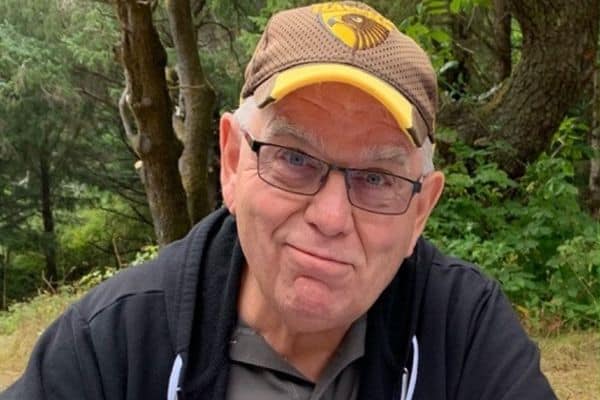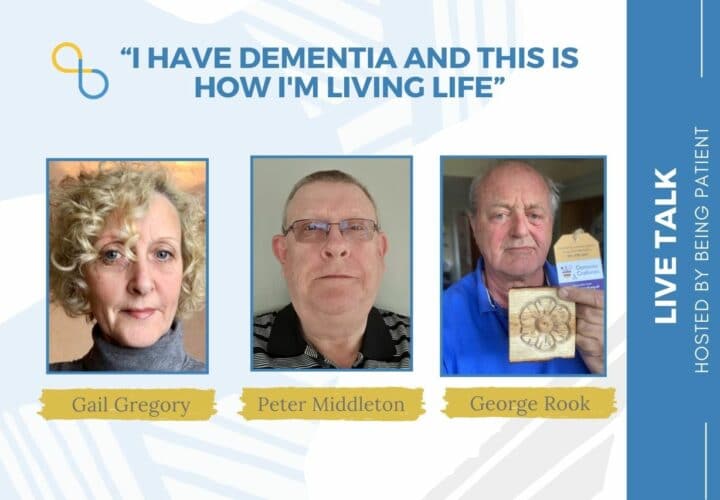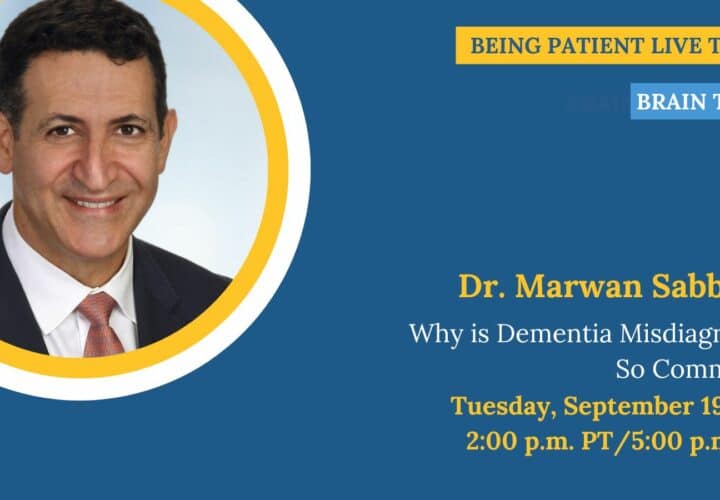Diagnosed with Alzheimer’s more than a decade ago, Wally Cox recounts his early warning signs, the emotional fallout following his diagnosis, and the purpose he has found through peer support and art.
Dementia ran in Wally Cox’s family, and when he was in his early 60s, he noticed subtle lapses in memory that were getting in the way of his work as an insurance agent with AAA. He saw a specialist and came home with a diagnosis: mild cognitive impairment, a precursor to dementia. Just one more year later, his doctor broke more serious news: It was Alzheimer’s. And in fact, his doctor said, Cox likely had just “four years left to live.”
That was more than a decade ago. Since, Cox pursued a revised diagnosis — and he chose to take control of his fate: He is living well with dementia, and serving as an advocate, a public speaker, and a mentor to others living with dementia, through peer support groups like Dementia Alliance International and Re-Imagining Dementia. “Every day is a choice,” Cox said. “I chose to look outward instead of inward at my disease and see my family, friends, motor-homing, barbecuing, riding bikes—all the things we like to do.” Cox also embraced art as therapy, transforming doodles and sketches into vivid scenes that explore fear, resilience, and hope.
In a recent conversation with Being Patient’s Mark Niu, Cox discussed the emotional turbulence of receiving what he calls a “tragedy diagnosis,” the pivotal role of community in combating isolation, and how artistic expression helps him reframe life with dementia as a chapter of growth rather than decline. Read on or watch the conversation.
Being Patient: Wally, first tell us about your condition and when you first began noticing signs where things didn’t seem quite right?
Wally Cox: I was an insurance agent with AAA for decades, and at work I started suddenly struggling with things that had been routine, like recognizing icons on my screen. I’d come in [to work], and sometimes they’d redo the computer and the icons and move [them] around, and I couldn’t remember which icon went with what, and I had to get my assistant to help me. I was at a school-board meeting, and they started a big discussion about a project we were working on. I’m sitting there thinking, “I have no idea what they’re talking about.” I made it to the end of the two-hour meeting not remembering what we were talking about or why, even though it was something we’d been working on and supposedly read, but I couldn’t remember it.
I went home to my wife and said, there’s just something wrong. I had people come in and say, “We were here yesterday, Wally, and you’re supposed to have this quote worked up for us.” I’m looking at them thinking, “It’s not that I forgot your name — I don’t even recognize you. Is somebody gaslighting me? Obviously not. Something’s wrong.” So we went to the family physician, actually for my wife’s appointment, and I said, “By the way, I’m having this problem and this problem.” He gave me a couple of little tests and said, “I’m going to make you an appointment and we’re going to send you to Stanford to have somebody take a look at you. You might’ve had a little stroke or something, but we’ll take a peek.”
We went to Stanford, and I was diagnosed with mild cognitive impairment, which I call “Alzheimer’s light.” It’s a diagnosis that something’s wrong. They don’t yet know what it is, or whether it will go forward, backward, or remain where it’s at. That’s pretty much the normal operation, because they don’t want to give you the big-hammer news right away. They want time to look at you today and then see you in six months or a year. A year later, after a bunch of exams, they said, “It’s apparent to us you have Alzheimer’s.”
Being Patient: And you’re how old at this time?
Cox: Around 62, 63. The doctor said, “You probably have four years left to live, two at home if you’re lucky, and you’ll be institutionalized, and then you’ll be dead within four years. This is pretty much guaranteed what’s going to happen if this diagnosis is correct.”
“The doctor said, ‘You probably have
four years left to live, two at home if you’re lucky,
and you’ll be institutionalized, and
then you’ll be dead within four years.'”
Being Patient: That was how many years ago?
Cox: That was 10 years ago.
Being Patient: And here you are doing an interview and talking very clearly about everything.
Cox: What we say in [the support] group is, “You’ve seen one case of dementia; you’ve seen one case of dementia.” There’s no certainty to these diagnoses as of right now. There’s some indications after a little bit of watching you as to where you’re probably going to go.
“What we say in [the support] group is,
‘You’ve seen one case of dementia;
you’ve seen one case of dementia.’
There’s no certainty to these
diagnoses as of right now.”
I got diagnosed with Alzheimer’s, and then a year or two later, because of the distance, we went to a[nother] doctor and he said, “No, I think you got Frontotemporal [dementia], I’m positive.”
And [I asked] what do we do about that? [The doctor said], “We can’t do any more about that than we really do about Alzheimer’s.” So I’m thinking, “Who cares? Then what’s the difference?” I got invited to be part of a study at [the University of California, San Francisco], and they took me down there and they spent about three or four days working me over and said, “You definitely don’t have Alzheimer’s and you definitely don’t have [FTD], but you have a slow-moving version, like an Alzheimer’s.”
Parts of the left front of my brain showed issues in some of the way my thinking goes. This fits in with my background, because [when] my grandmother died she was senile. My dad died just a few years ago with dementia. He was institutionalized for probably the last six years of his life. His sister died with dementia. My brother, who’s actually 20 years younger than me, he has, they’re pretty sure, Lewy body disease and Parkinson’s. So there seems to be a run through our family of people with these kinds of issues. But my dad first started having problems in his 60s, like I did. We just thought he was being obstinate. He couldn’t figure out how to use the computer and he’d forget stuff. He lived about 25 years with this problem, but slowly declined.
Fortunately, most of my issues are in executive functioning. Things that I did a lot [while working] — like reading policies and contracts, writing up deals, adding, subtracting, and dividing — I’m incapable of now. I find it very difficult, even to figure out how much of a tip I’m supposed to leave. I always have my wife check. I put the money down and I don’t add it up correctly in my mind. I’m confident that I did it right, but I didn’t. From my eyes looking out, I think, hey, I’m still firing on all cylinders. That’s typical of a lot of people with dementia. They’re the last person to see it. But I was fortunate enough to recognize that something was really wrong. And I think a lot of that had to do with watching my dad’s decline. We were care providers for him at the end of his life, so we saw that path.
Being Patient: You talk a lot about the diagnosis process and how you feel doctors leave you hanging out to dry. How were you able to cope with your diagnosis and get the help that you needed?
Cox: I’ve heard it described as the “tragedy diagnosis.” It’s all over but the singing. I think doctors — as a whole — want to cure you. They want to fix things, and it’s a disease that you can’t fix. So it’s very difficult for your physician or care person to give you news that they can’t take care of you. I can’t help but think they feel like a failure. A lot of times you have close connections to these people, and they learn to like you or love you, and then they have to give you this news that is devastating.
“I was fortunate enough to recognize
that something was really wrong. And I
think a lot of that had to do with
watching my dad’s decline.”
I went home after the diagnosis; my wife said when we got in the car, “I’ll never leave you.” It meant a lot to me right then, because I was pretty hammered. We went home and I dug a hole, pulled a rock over my head. I resigned from the school board. I hid from people and I was ashamed — terribly ashamed. One thing that comes with this diagnosis is shame and it’s unfortunate, but it is what it is. I proceeded to build this wall between my wife and myself, because I wanted to cut myself off emotionally. I didn’t want to deal with it. In her wisdom, she said. “There’s an Alzheimer’s group we can get involved in.”
So we go to this Alzheimer’s group. We went into this room and they started telling us about the disease and asking how we’re feeling. The second week I was there, I said, “How many of you guys thought about killing yourself so far?” Every hand in the room but one went up. I thought, “Wow, it’s not just me.” Because I’m thinking maybe I should, for the sake of my wife and my family, I should just end my life and get out of the way. That’s how you feel. And that’s how it’s projected to you – there’s no point in going on.
In that group, there were a couple of people that were outspoken about their diagnosis. In getting together with these people, then eventually through Dementia Alliance International (DAA), and Reimagining Dementia, I found my niche, I found my family. I connected with people who are experiencing the same thing I am. And it doesn’t always end well. It never does end well. But you get to see people live their lives and realize that there’s a lot you can still do despite your diagnosis. There’s a lot you can’t do. But there’s a ton that you can do, and some of the things that you can do are things that you wouldn’t have done had you still been going to work or climbing that next hill that you think you have to climb. It ended up being, in many ways, a blessing. I quit a job that was starting to overwhelm me. The stress was sky high.
I live a fairly stress-free existence now. I spend a lot of time in our groups talking particularly to people who’ve been recently diagnosed that this isn’t the end of your life; it’s just another chapter. I know that’s a cliché, but it’s true. And there’s still a lot to do. I can still garden, I can still ride a bike, I can still go for a walk, and I actually can still drive a car, although I try to do it as little as possible, and love my children. This diagnosis has given me time to re-ignite my faith, to re-strengthen my relationships with my family and my children and my friendships, to reinvigorate our marriage. So despite the horror, it’s been a blessing. And I think that’s the old story about making lemonade out of lemons. I have two choices. I can give up or I can get out, and I decided to get out.
“I spend a lot of time in our groups
talking particularly to people who’ve
been recently diagnosed that this isn’t
the end of your life; it’s just another chapter.”
Being Patient:You shared a C. S. Lewis quote: “Friendship is born at that moment when one person says to another, ‘What! You too? I thought I was the only one.’”
Cox: Yes, exactly. The most important thing [I could tell] anybody who has been recently diagnosed or is diagnosed and they’re suffering from depression and malaise is to get connected with other people that are on the same journey; it’s invigorating. I go to groups during the week and I come out and sometimes it’s sad and sometimes it’s hilarious. Everybody there knows what you’re going through when you talk about how you got up in the morning and forgot to take your pills and you forgot this and you forgot that. And it’s important to get connected because your two choices are to go through this alone or go through this connected. I’d much rather go through it connected. I’ve always liked people and enjoyed conversations. I still have my voice, which not everybody’s fortunate enough to [have]. But even if you don’t have your voice, you can still go to the group and listen.
Being Patient: You’ve also turned to art — what started that?
Cox: I doodle a lot when I’m in group. A lot of times people will say, you look like you’re not paying attention. I’m usually drawing— I like to draw and paint. I doodle a lot and draw things that catch my attention. I like to draw things that I’m thinking about and some of my doodles are specific to [emotions] I’m going through and sometimes my doodles are just playful.
Being Patient: Can you explain the symbolism in your drawing about walls?
Cox: I was my wife’s care provider for a while, years ago. We’ve been together since we were kids. We were told she was dying from lupus. I was very angry and had distanced myself from her, which is not our normal way of living. She survived but while we were in it, I said to a friend of mine, who’s a psychologist, “I don’t understand what’s going on. I’m so angry.” He said, “You’re building a wall between you and her because it’s going to hurt if you lose her. You still have three kids at home.” I [was] building a wall so if she’s torn away from me it doesn’t rip my heart out. So I built connections instead of walls between me and her. And she survived. She told me later on that it meant everything in the world to her, that she and I were still connected, that she knew I was there, even though she couldn’t really see me because she was slipping in and out of a coma.
Fast forward 15 years and I get diagnosed with Alzheimer’s. Now I’m the person who’s sick, right? And what’s the first thing I start doing? Well, I started building a wall. I have heartache, loss, self-preservation, self-doubt, the unknown, anxiety, fear. These are the things I’m playing with, constructing this barrier between me and my wife because of fear, anxiety, despair — instead of opening my heart and making myself vulnerable. She pointed that out and said, you’re doing exactly what you’re not supposed to do.
I decided there are two paths. My conclusion, as I was drawing [was that] every day is a choice. I chose to look outward instead of inward at my disease and see my family, friends, motor-homing, barbecuing, riding bikes — all the things we like to do. I’m drawing down how I want to live.
“My conclusion, as I was drawing [was that]
every day is a choice. I chose to look
outward instead of inward at my disease and
see my family, friends, motor-homing,
barbecuing, riding bikes—
all the things we like to do.”
Being Patient: What does [drawing] do for your mind? Does it calm it? Make it more focused?
Cox: I can sit down and start drawing and time disappears. Other than hunger and other needs that you have, I would just keep drawing. When I get in the mood, I draw and I draw and draw. Then I don’t. Sometimes I don’t draw for weeks and then I draw again.
I don’t know if there’s some emotional part of that; I think there might be because sometimes I need to put things I’m thinking about on paper, and I find instead of writing poetry or a book, it’s easier to draw something that expresses how I feel. The other day, I was going through something and I drew a sketch of a guy yelling, “You’re not hearing me.” I also have one down here that says, “You’re not hearing me.” Sometimes I wonder which one you need to get your message across to somebody you’re talking to. Sometimes the quieter approach is better, but sometimes you feel like you need to belt it out. I enjoy art and I would certainly urge anybody with time on their hands to give it a shot.
Being Patient: I want to close with giving you the chance, If you had any one piece of advice to offer those recently diagnosed with Alzheimer’s or dementia.
Cox: There’s a quote I read a long time ago: “The acorn has no knowledge of the oak tree.” We have oak trees all over our property, and in the fall they shoot their acorns out like bullets. They bounce off your roof, and that acorn hits the ground and thinks. I’ve been torn asunder and my life’s over as I know it. Eventually a squirrel puts it in the ground and it thinks, now I’m really screwed,” and later it comes up and ends up being a big giant oak tree. We’re on this journey, and we fought our way out.
When we were born, we didn’t want to be outside. We liked it where we were — quiet. Then you come out, and you think, after a while, I don’t want to be back there. I want to be where I’m at. We don’t know where the next part of our journey goes. We know it goes somewhere, but we don’t know. Many of us have our faith, but all of us are on that journey. We’re all going to the same place together. I think you need to get up every morning and decide for yourself what path you want to follow— the path of despair and destruction, or the path of hope and love. I wish for all of you to follow the path of hope and love, because it’s a much more enjoyable way to live.




Wow! What an inspiration Mr. Cox is! I had tears in my eyes at times, a big smile at others, and just a head nod at others. Thank you to him for sharing his amazing journey, and thank you to Being Patient for making it available for your audience.
Hi Maryann, thank you for your comment. We appreciate your support!